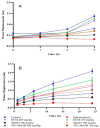Bioactive Compounds, Antioxidant, Anti-Inflammatory, Anti-Cancer, and Toxicity Assessment of Tribulus terrestris-In Vitro and In Vivo Studies
- PMID: 35740057
- PMCID: PMC9219970
- DOI: 10.3390/antiox11061160
Bioactive Compounds, Antioxidant, Anti-Inflammatory, Anti-Cancer, and Toxicity Assessment of Tribulus terrestris-In Vitro and In Vivo Studies
Erratum in
-
Correction: Abbas et al. Bioactive Compounds, Antioxidant, Anti-Inflammatory, Anti-Cancer, and Toxicity Assessment of Tribulus terrestris-In Vitro and In Vivo Studies. Antioxidants 2022, 11, 1160.Antioxidants (Basel). 2024 Apr 17;13(4):471. doi: 10.3390/antiox13040471. Antioxidants (Basel). 2024. PMID: 38671949 Free PMC article.
Abstract
Tribulus terrestris L. belongs to the family Zygophyllaceae and integral part of various ancient medicinal systems including Chinese, Indian, and European to combat various health ailments. The aim of the present study was to assess the phytochemical constituents, in vitro antioxidant activity using DPPH, FRAP, and H2O2 assays, in vitro anticancer activity using MTT assay, and in vitro and in vivo anti-inflammatory properties of T. terrestris. The acute and sub-acute toxicity of extracts exhibiting most biological potential was examined using murine models. Liquid-liquid partitioning followed by RP-HPLC sub-fraction of crude extract was performed. After that, ESI-MS/MS analysis was done for the timid identification of bioactive metabolites responsible for bioactivities of sub-fractions and HPLC analysis to quantify the compounds using external standards. Among all extracts, T. terrestris methanol extract was noted to hold maximum phenolic (341.3 mg GAE/g) and flavonoid (209 mg QE/g) contents, antioxidant activity in DPPH (IC50 71.4 µg/mL), FRAP (35.3 mmol/g), and H2O2 (65.3% inhibition) assays, anti-inflammatory activities in vitro at 400 µg/mL (heat-induced hemolysis, % inhibition 68.5; egg albumin denaturation, % inhibition 75.6%; serum albumin denaturation, % inhibition 80.2), and in vivo at 200 mg/kg (carrageenan-induced paw edema, % inhibition 69.3%; formaldehyde-induced paw edema, % inhibition 71.3%) and anticancer activity against breast cancer cell (MCF-7) proliferation (IC50 74.1 µg/mL). Acute and sub-acute toxicity studies recorded with no change in body weight, behavior, hematological, serum, and histopathological parameters in treated rats with T. terrestris methanol extracts when compared to control group. Fraction B obtained through liquid-liquid partitioning resulted in more bioactive potential as compared to the parent methanol extract. RP-HPLC analysis of fraction B resulted with four sub-fractions (TBTMF1-TBTMF4), wherein TBTMF3 delineated notable bioactive capabilities as compared to other fractions and parent methanol extract. ESI-MS/MS analysis of TBTMF3 resulted with tentative identification of myricetin, rutin, liquitrigenin, physcion, and protodioscin. It can be stated that T. terrestris is a potential bearing herb and findings of current study further verify the claims made in ancient medicinal systems. However, after investigation of each identified compound, it must be considered for drug discovery.
Keywords: ESI-MS/MS; RP–HPLC; antioxidant; bioassay-guided fractionation; cancer; inflammation; liquitrigenin; myricetin; phytochemicals; rutin; toxicity.
Conflict of interest statement
The authors declare no conflict of interest.
Figures



Similar articles
-
Bioactivity Profiling and Phytochemical Analysis of Carissa carandas Extracts: Antioxidant, Anti-Inflammatory, and Anti-Urinary Tract Infection Properties.Antioxidants (Basel). 2024 Aug 27;13(9):1037. doi: 10.3390/antiox13091037. Antioxidants (Basel). 2024. PMID: 39334696 Free PMC article.
-
Antioxidant and Anti-Inflammatory Effects of Peganum harmala Extracts: An In Vitro and In Vivo Study.Molecules. 2021 Oct 8;26(19):6084. doi: 10.3390/molecules26196084. Molecules. 2021. PMID: 34641627 Free PMC article.
-
Syzygium cumini(L.),Skeels fruit extracts: In vitro and in vivo anti-inflammatory properties.J Ethnopharmacol. 2021 May 10;271:113805. doi: 10.1016/j.jep.2021.113805. Epub 2021 Jan 16. J Ethnopharmacol. 2021. PMID: 33465442
-
Dryopteris juxtapostia Root and Shoot: Determination of Phytochemicals; Antioxidant, Anti-Inflammatory, and Hepatoprotective Effects; and Toxicity Assessment.Antioxidants (Basel). 2022 Aug 27;11(9):1670. doi: 10.3390/antiox11091670. Antioxidants (Basel). 2022. PMID: 36139744 Free PMC article.
-
Exploring the anti-inflammatory, sedative, antidiabetic, and antioxidant potential in in-vitro and in-vivo models and phenolic profiling of Atractylis aristata Batt.J Ethnopharmacol. 2024 Aug 10;330:118252. doi: 10.1016/j.jep.2024.118252. Epub 2024 Apr 23. J Ethnopharmacol. 2024. PMID: 38663782
Cited by
-
CAXII inhibitors: Potential sensitizers for immune checkpoint inhibitors in HCC treatment.Front Immunol. 2023 Mar 16;14:1052657. doi: 10.3389/fimmu.2023.1052657. eCollection 2023. Front Immunol. 2023. PMID: 37006233 Free PMC article. Review.
-
Tiliroside suppresses triple-negative breast cancer as a multifunctional CAXII inhibitor.Cancer Cell Int. 2022 Nov 24;22(1):368. doi: 10.1186/s12935-022-02786-6. Cancer Cell Int. 2022. PMID: 36424626 Free PMC article.
-
Unveiling root nodulation in Tribulus terrestris and Roystonea regia via metagenomics analysis.Mol Genet Genomics. 2024 Dec 28;300(1):9. doi: 10.1007/s00438-024-02218-2. Mol Genet Genomics. 2024. PMID: 39731654
-
In-vitro antibacterial, antioxidant and anti-inflammatory and In-silico ADMET, molecular docking study on Hardwickia binata phytocompunds with potential inhibitor of skin cancer protein.In Silico Pharmacol. 2023 Sep 23;11(1):25. doi: 10.1007/s40203-023-00163-3. eCollection 2023. In Silico Pharmacol. 2023. PMID: 37750071 Free PMC article.
-
Correction: Abbas et al. Bioactive Compounds, Antioxidant, Anti-Inflammatory, Anti-Cancer, and Toxicity Assessment of Tribulus terrestris-In Vitro and In Vivo Studies. Antioxidants 2022, 11, 1160.Antioxidants (Basel). 2024 Apr 17;13(4):471. doi: 10.3390/antiox13040471. Antioxidants (Basel). 2024. PMID: 38671949 Free PMC article.
References
-
- Rodriguez V.L., Davoudian T. Treating Comorbid Opioid Use Disorder in Chronic Pain. Springer; Cham, Switzerland: 2016. Clinical Measurement of Pain, Opioid Addiction, and Functional Status; pp. 47–56.
-
- Charepalli V., Reddivari L., Vadde R., Walia S., Radhakrishnan S., Vanamala J.K.P. Eugenia jambolana (Java Plum) fruit extract exhibits anti-cancer activity against early stage human hct-116 colon cancer cells and colon cancer stem cells. Cancers. 2016;8:29. doi: 10.3390/cancers8030029. - DOI - PMC - PubMed
-
- Stanković N., Mihajilov-Krstev T., Zlatković B., Stankov-Jovanović V., Mitić V., Jović J., Čomić L., Kocić B., Bernstein N. Antibacterial and antioxidant activity of traditional medicinal plants from the Balkan Peninsula. NJAS—Wagening. J. Life Sci. 2016;78:21–28. doi: 10.1016/j.njas.2015.12.006. - DOI
LinkOut - more resources
Full Text Sources
Other Literature Sources
Miscellaneous

